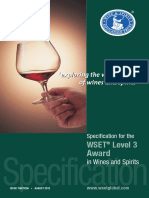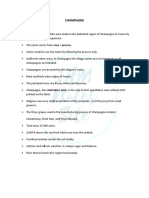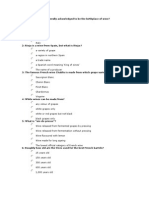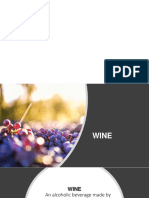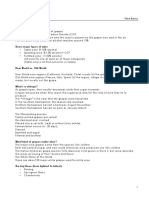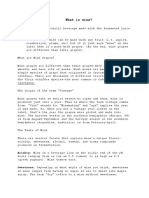Champagne
Champagne
Uploaded by
Annete AzaliaCopyright:
Available Formats
Champagne
Champagne
Uploaded by
Annete AzaliaCopyright
Available Formats
Share this document
Did you find this document useful?
Is this content inappropriate?
Copyright:
Available Formats
Champagne
Champagne
Uploaded by
Annete AzaliaCopyright:
Available Formats
Champagne (wine)
Champagne (wine), sparkling wine produced by a traditional method in the Champagne region around Reims and pernay in northeastern France. The word is derived from the Latin campagna, meaning countryside, a name for this area of France since the Middle Ages. Although other French wine-producing regions claim to have made sparkling wine earlier, this area was the first place to produce it in significant quantities. Grape vines were first planted in the area by monks from the local abbeys. At first, the only wines produced there were still (not sparkling) table wines. In the late 17th century, however, clerical winegrowers made the transition from still to sparkling wines. Legend has it that the Benedictine monk, Dom Prignon, invented champagne. Although Dom Prignon was an important figure in the development of viticulture (the cultivation of grapes) and wine-making, sparkling wine probably emerged gradually as part of a regional style. It may also have emerged by default as the cold winters in northern France caused table wine to stop fermenting and start up again in the spring, producing bubbles in the bottle. It was not until the first half of the 19th century that a thriving commercial business sprang up to produce champagne, when such famous champagne houses as Veuve Clicquot, Krug, Bollinger, and Mot et Chandon were established. The method of production used by them remains the same today: the first fermentation produces still, acidic wine. Before this is bottled, a small measure of wine, sugar, and yeast is added (known as the liqueur de tirage) and the bottle is sealed. The liqueur de tirage triggers a second fermentation inside the bottle, and the carbon dioxide bubbles are trapped inside. The bottle is tilted upside down and turned at regular intervals to shake the yeasty deposits down into the neck. At the end of this process, known as remuage, the neck is frozen and the bottle opened to allow a plug of icy lees (sediment) to shoot out (dgorgement). The bottle is then topped off with a small amount of still wine and sugar solution (called liqueur
dexpdition) and resealed. The amount of sugar used at this point determines whether the
champagne is Brut (very dry), Sec (off-dry), or Demi-Sec (medium-sweet). Classic champagne characteristics produced by this labor-intensive method are a toasty or yeasty scent, high acidity, elegant fruit character, and a complex depth of flavor. This process of making sparkling wine has been copied by wine-makers in many other parts of the world. These producers may put the words mthode traditionnelle on bottles to indicate that the champagne method has been used, but they may not use the words champagne or mthode
champenoise. While defined as a white sparkling wine, there are varieties of champagne. The
three grapes used in champagne production are white Chardonnay and the red varieties Pinot Noir and Pinot Meunier. Wine-makers must be careful to acquire clear juice from the red grapes for standard champagne. To make ros champagne, a small proportion of still red wine made from Pinot vines is usually added after first fermentation. Ros champagne tends to have a more fruity character. Champagne labeled blanc de blancs is made only from Chardonnay grapes, blanc de
noirs from red grapes alone. Vintage champagne comes from the wine of a single year only;
nonvintage can be a blend of wines from different years. Microsoft Encarta 2007. 1993-2006 Microsoft Corporation. All rights reserved.
You might also like
- WSET Level 3 Practice QuestionsDocument38 pagesWSET Level 3 Practice QuestionstsangjasNo ratings yet
- D5 Practice QuestionsDocument11 pagesD5 Practice QuestionsIvan ClavierNo ratings yet
- BBS Book (PT 14) NeglyDocument7 pagesBBS Book (PT 14) Neglyapi-3871208No ratings yet
- Austrian Wine in Depth - Februar 2013Document100 pagesAustrian Wine in Depth - Februar 2013nevena_milinovic0% (1)
- Certified Examinable Grapes & Growing Regions WHITE-June - 2016 - 0Document1 pageCertified Examinable Grapes & Growing Regions WHITE-June - 2016 - 0DominikaJędrzejewska100% (1)
- Exploring The World of Wines and SpiritsDocument42 pagesExploring The World of Wines and SpiritsÖzgecan Cesur100% (2)
- Sparkling Wine: Muntean Maxim TVPF-191Document9 pagesSparkling Wine: Muntean Maxim TVPF-191Tony WilliamsNo ratings yet
- 12 ChampagneDocument7 pages12 ChampagnenimishsdNo ratings yet
- WinequizzesDocument81 pagesWinequizzesvijuav100% (1)
- WinesDocument34 pagesWinesWendie LlagasNo ratings yet
- Sparkling WinesDocument5 pagesSparkling WinesamanNo ratings yet
- The Wines of FranceDocument10 pagesThe Wines of Francenimishsd100% (2)
- Wine RegionDocument42 pagesWine RegionPrashant AryaNo ratings yet
- Hello Burgundy: A Guide to the Great Grand Cru Vineyards of BurgundyFrom EverandHello Burgundy: A Guide to the Great Grand Cru Vineyards of BurgundyNo ratings yet
- Wines of The French Alps: Savoie, Bugey and beyond with local food and travel tips.From EverandWines of The French Alps: Savoie, Bugey and beyond with local food and travel tips.No ratings yet
- Ustralia: IstoryDocument7 pagesUstralia: IstoryXavier PokharelNo ratings yet
- Grape ProductDocument4 pagesGrape Productphoenix rogueNo ratings yet
- Final Wines PresentationDocument21 pagesFinal Wines Presentationsachin rana100% (1)
- Concepts - Italian Wine AppelationsDocument4 pagesConcepts - Italian Wine Appelationsgata kamskyNo ratings yet
- Top Producing Wine Regions of The WorldDocument32 pagesTop Producing Wine Regions of The WorldMarin GarazNo ratings yet
- Response Australian ChardonnayDocument2 pagesResponse Australian ChardonnayjextxadoreNo ratings yet
- Wines To Taste: Common Region (Burgundy)Document7 pagesWines To Taste: Common Region (Burgundy)jextxadoreNo ratings yet
- This Study Resource Was: Sauvignon BlancDocument1 pageThis Study Resource Was: Sauvignon BlancJosh Movtchan100% (1)
- 2020-05-24 Rhône Valley & Southern France Tasting (Marked)Document6 pages2020-05-24 Rhône Valley & Southern France Tasting (Marked)jextxadoreNo ratings yet
- Bar Exam Practice 11Document4 pagesBar Exam Practice 11skye72No ratings yet
- Storing and Serving WineDocument3 pagesStoring and Serving WineJoao RicoNo ratings yet
- Week 2 Exam Practice-Whole Bunch Fermentation: Hugo Poon February 27, 2020Document5 pagesWeek 2 Exam Practice-Whole Bunch Fermentation: Hugo Poon February 27, 2020jextxadoreNo ratings yet
- Mock Exam 4 WSET L3Document7 pagesMock Exam 4 WSET L3greenhandkoNo ratings yet
- Italian Wine PDFDocument11 pagesItalian Wine PDFgolmatolNo ratings yet
- Examiners' Report For October 2021Document21 pagesExaminers' Report For October 2021Cecilia ChansiinNo ratings yet
- This Study Resource Was: ChardonnayDocument1 pageThis Study Resource Was: ChardonnayJosh MovtchanNo ratings yet
- Basics About ServingDocument17 pagesBasics About ServingMarin GarazNo ratings yet
- Session 6Document26 pagesSession 6Bancha KumjanNo ratings yet
- Wines To Taste: Wine 1: Sauska, Furmint Medve-Dűlő 2015, TokajDocument3 pagesWines To Taste: Wine 1: Sauska, Furmint Medve-Dűlő 2015, TokajjextxadoreNo ratings yet
- Session 5Document30 pagesSession 5Bancha KumjanNo ratings yet
- Session 7, Other Black Grape Varieties and Red WinesDocument19 pagesSession 7, Other Black Grape Varieties and Red WinesBirkNo ratings yet
- What Is Wine?: Vinifera. There Are Thousands of Different Varieties Within SauvignonDocument55 pagesWhat Is Wine?: Vinifera. There Are Thousands of Different Varieties Within SauvignonAira Joyce LimpinNo ratings yet
- Instant Download D3: Wines of the World – An accompaniment to the WSET Level 4 Diploma in Wines Wine & Spirit Education Trust PDF All ChaptersDocument50 pagesInstant Download D3: Wines of the World – An accompaniment to the WSET Level 4 Diploma in Wines Wine & Spirit Education Trust PDF All Chaptersborelcacasob100% (1)
- WSET Level 1 Element 2Document6 pagesWSET Level 1 Element 2ManyaNo ratings yet
- South African Wine Educational CourseDocument16 pagesSouth African Wine Educational CoursezuilinhaNo ratings yet
- WSET Flashcards PDFDocument34 pagesWSET Flashcards PDFrahuulNo ratings yet
- Tim Atkin Wine Report Burgundy 2009Document42 pagesTim Atkin Wine Report Burgundy 2009luizcolaNo ratings yet
- 2020-03-21 Week 12.2 Revision Week Tasting - 3Document1 page2020-03-21 Week 12.2 Revision Week Tasting - 3jextxadoreNo ratings yet
- Wset Level 2 Wines and Spirits ExamDocument22 pagesWset Level 2 Wines and Spirits ExamkapedispursNo ratings yet
- Wset Program Details: Level 1wines Program Deails Who Should ApplyDocument1 pageWset Program Details: Level 1wines Program Deails Who Should ApplyAnkit KumarNo ratings yet
- Final Assignment BORDEAUX WINEDocument15 pagesFinal Assignment BORDEAUX WINESiddharth SehgalNo ratings yet
- Wines of Chile 8Document20 pagesWines of Chile 8vskywokervsNo ratings yet
- Week 5 - StudentDocument51 pagesWeek 5 - StudentAnny HoNo ratings yet
- Albarino Wine: History, Origin and ClimateDocument12 pagesAlbarino Wine: History, Origin and Climatesamiran dekaNo ratings yet
- Italian Questions (Multiple Choices and Short Answers) - Lily 30.8.2023Document3 pagesItalian Questions (Multiple Choices and Short Answers) - Lily 30.8.2023Lily TranNo ratings yet
- D5 Fortified Wine Topics - AnswersDocument13 pagesD5 Fortified Wine Topics - AnswersIvan ClavierNo ratings yet
- French Wines: France Hectolitres Spain ItalyDocument9 pagesFrench Wines: France Hectolitres Spain ItalymatmanuNo ratings yet
- Red WinesDocument3 pagesRed WinesPham Phuong HoaNo ratings yet
- Red Wine vs. White Wine: What's The Difference?: Tongue, Meet TanninsDocument5 pagesRed Wine vs. White Wine: What's The Difference?: Tongue, Meet TanninsShanghaï LiNo ratings yet
- Grapevine Communication - Lesson 3Document5 pagesGrapevine Communication - Lesson 3Solomon Reuben IrmiyaNo ratings yet
- GichanDocument5 pagesGichanDjvans Samanamud OsorioNo ratings yet
- Service of White Wine Materials RequiredDocument8 pagesService of White Wine Materials RequiredAakash DasNo ratings yet
- Grape Production Critical Review in The World: SSRN Electronic Journal May 2020Document56 pagesGrape Production Critical Review in The World: SSRN Electronic Journal May 2020雪翼wingxyNo ratings yet
- 2H Cruise On Danube River PDFDocument2 pages2H Cruise On Danube River PDFMaia OdishariaNo ratings yet
- Domaine Gérard Boulay Sancerre Les Monts DamnésDocument2 pagesDomaine Gérard Boulay Sancerre Les Monts DamnésYing CaiNo ratings yet
- Wines of PortugalDocument6 pagesWines of PortugalDeepak JettaNo ratings yet
- PDFDocument80 pagesPDFGCMediaNo ratings yet
- Anamaria Petrescu Curriculum Vitae EnglezaDocument3 pagesAnamaria Petrescu Curriculum Vitae EnglezaAnamaria PetrescuNo ratings yet
- Wine ListDocument8 pagesWine ListeatlocalmenusNo ratings yet
- World Famous French WineDocument21 pagesWorld Famous French WineSumit PandeyNo ratings yet
- Syrah 1Document2 pagesSyrah 1eshinds89No ratings yet
- Spanish Vineyard Tour 2011 - CatalogueDocument21 pagesSpanish Vineyard Tour 2011 - Catalogue黃郁心No ratings yet
- Jurnal AnatomiDocument24 pagesJurnal AnatomiReiiyhaAfriliaTamiNo ratings yet
- Supply BDG Sept - All Collections - PagenumberDocument28 pagesSupply BDG Sept - All Collections - PagenumberFutureistodayNo ratings yet
- Introduction of The Company: Administrative Management CollegeDocument63 pagesIntroduction of The Company: Administrative Management CollegeShivu PatilNo ratings yet
- Cutting Orders McLaren Vale Vine ImprovementDocument8 pagesCutting Orders McLaren Vale Vine ImprovementHooky1979No ratings yet
- AWD Shiraz FacilGuide RVDocument57 pagesAWD Shiraz FacilGuide RVVentajiakwamen TohomjiakiatoNo ratings yet
- Press Book Zucco Film 2013Document8 pagesPress Book Zucco Film 2013newtrack2013No ratings yet
- Wine Tasting TipsDocument13 pagesWine Tasting TipsAntonio CruzNo ratings yet
- Pocket Sommelier - Wine Tasting GuideDocument13 pagesPocket Sommelier - Wine Tasting GuidePocket100% (3)
- Wine Fundamentals Certificate Level 1: International Sommelier Guild Textbook ©Document167 pagesWine Fundamentals Certificate Level 1: International Sommelier Guild Textbook ©Ela RichNo ratings yet
- Perrier Jouet Wine SpeechDocument21 pagesPerrier Jouet Wine SpeechMichiel Sebastiaan DemareyNo ratings yet
- The Red WineDocument4 pagesThe Red WinecorinaciupNo ratings yet
- Reading The Wine Label: Mandatory MandatoryDocument4 pagesReading The Wine Label: Mandatory MandatorysachinNo ratings yet
- Wine Appreciation: By: Shiela Mae Reforba (12-GA 4)Document14 pagesWine Appreciation: By: Shiela Mae Reforba (12-GA 4)Manoy KulaNo ratings yet
- Flash DétenteDocument3 pagesFlash DétenteMosh_CDNo ratings yet
- Activity 0.1, 0.2, 0.3Document3 pagesActivity 0.1, 0.2, 0.3Jhay-ar Villas PerezNo ratings yet
- PhylloxeraDocument7 pagesPhylloxeraNicholas FeatherstonNo ratings yet






